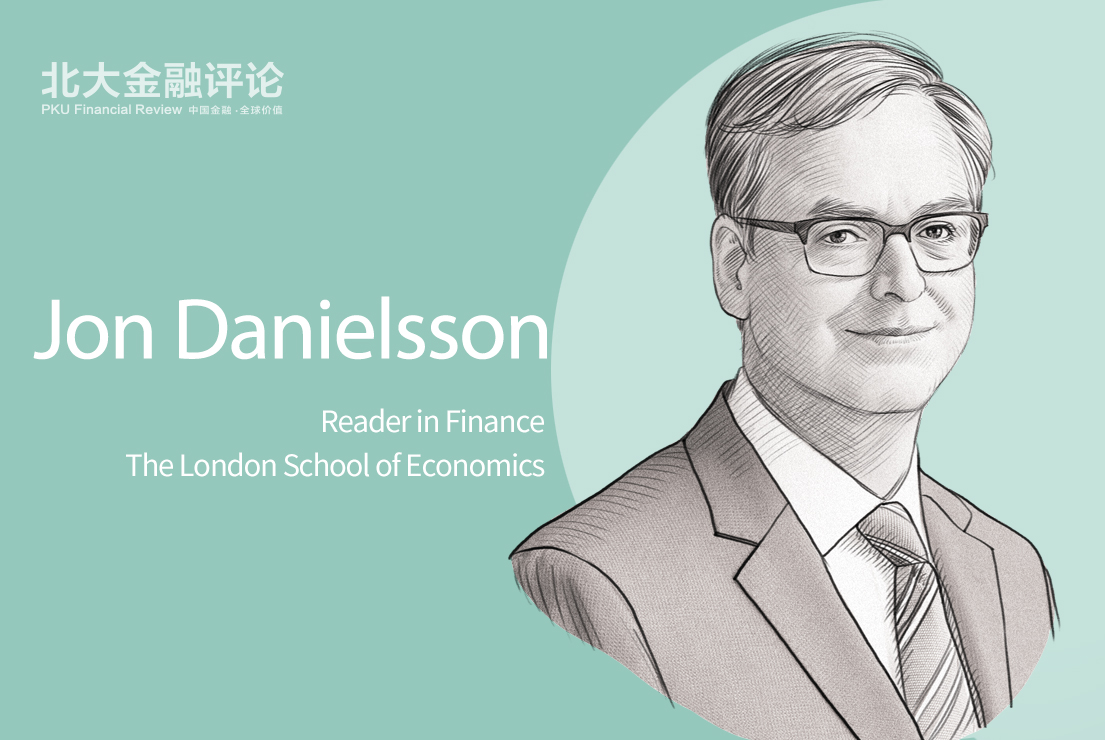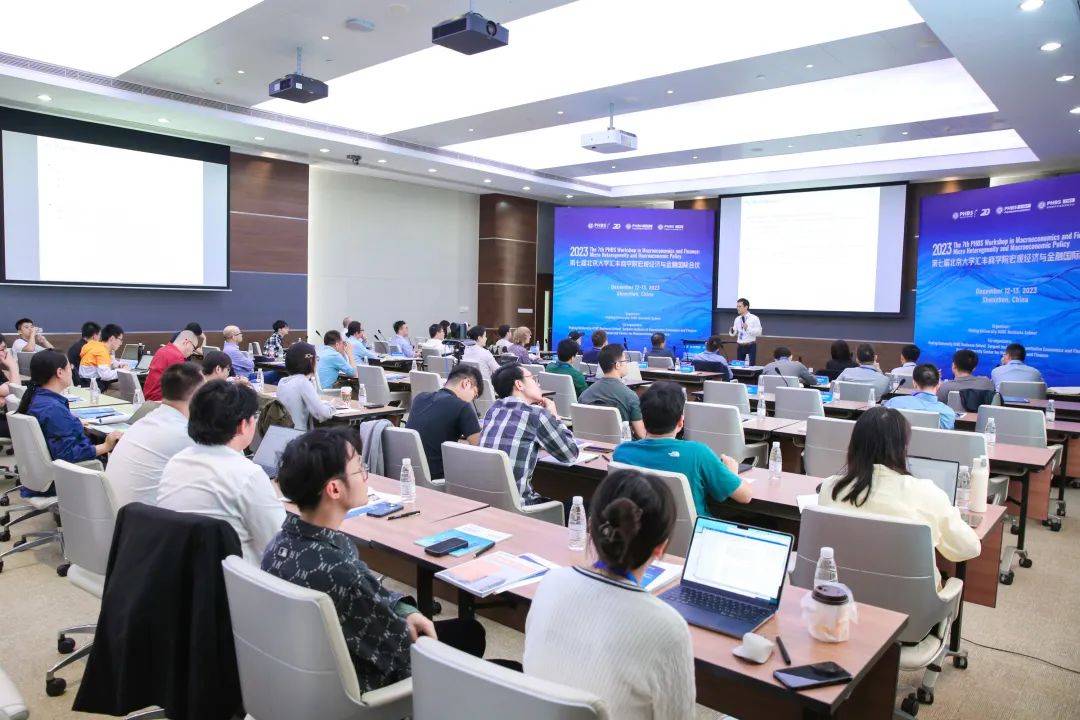Dr. Jon Danielsson is a Reader in Finance at the London School of Economics. His work focuses on artificial intelligence, risk forecasting, international finance, cryptocurrencies, and systemic causes of financial instability. He has written several books on finance and risk analysis, and is active in both domestic and international policy debates on financial regulation.
 PKU Financial Review: In the Illusion of Control, you mentioned the issue of short-term risk and long-term risk. You point out that short-term risks are not that important, both to investors and to financial authorities. However, for individual investors, they may encounter very few serious systematic risks in their lifetime, but will face quite a lot of daily short-term risks. So how do you persuade people to take the long view?
Jon Danielsson:
PKU Financial Review: In the Illusion of Control, you mentioned the issue of short-term risk and long-term risk. You point out that short-term risks are not that important, both to investors and to financial authorities. However, for individual investors, they may encounter very few serious systematic risks in their lifetime, but will face quite a lot of daily short-term risks. So how do you persuade people to take the long view?
Jon Danielsson: It's very difficult to convince people to do this. Because the processes we have in society always take us to the short-term. Everybody is thinking about what might happen tomorrow or happen next month. However, what we can do is that when we talk to especially fund managers that deal with long-term risk like a pension fund, a pension fund is thinking about something that may happen in the next 50 years or 30 years. Those people professionally understand long-term risk and those are the people we need to talk to. We can also talk to the financial authorities and try to convince them that if we are thinking about someone's long-term risk, we should also measure risk in the long term. So it's a question of education and communication with the entities that make investment.
But as for individual investor, they face short-term risks every day. So do you think it is rational for them to have to think in a short-term way instead of a long-term way? For a lot of investors, they care only about the short-term. So a lot of investors are simply looking to make short-term speculative profits, and if you are a short-term investor that wants to make money. Let's say you buy a stock. You want to sell it next month and you buy a house. You want to sell it next year for a profit, then you are a short-term investor.
However what I think is that those investors who are thinking long-term. They often tend to be more sophisticated and they tend to be the people who see through this cycle. So what we can do is that we can educate investors to think about the short-term and the long-term. If they look at education materials, like give them advice, then maybe we can help them. But however, in English there is an expression, “you can take a horse to water, but it can't make the horse drink”. We can tell people about the long-term and the short-term. But if they don't want to do it then, we can't help them.
PKU Financial Review: You mentioned in the book that one of your favorite papers is "The Emperor Has No Clothes: Limits to Risk Modeling", and the core idea is that it is impossible to measure risk perfectly, which is why you are critical of Basel ii. But in the stage economic downturns, confidence is very important, because people's high sensitivity to risk may lead to deflation. So what do you think about this situation?
Jon Danielsson: By the time you're already in a downturn, it's almost too late to do something about it, except manage it. So I think we really should think about it as a whole process from the up-swing to the down-swing. What we need to do our society is, we need to find a way to prevent the absence from becoming too big, and that is of course is very difficult to do. But that is very important because what happens is human beings they go from being very optimistic to very pessimistic. I think this is just human psychology and the psychology of investors. But it's also the psychology of the government officials at the top of the agencies.
In my paper
The Emperor Has No Clothes, what I find is that when the economy is doing well, we measure risks as being too low. And when the economy is doing badly, we measure risk as too high. That leads to pro-cyclical behavior, it encourages us to be too optimistic when things are good, and too pessimistic when things are bad. Therefore, anybody thinking about the cycle, the up-swing and the down-swing needs to be aware that the risk measurements are misleading. They tell us the wrong thing. Therefore, from a policy point of view, if you are a government agency, when things are really doing well, as a policy, it's sensible to try to slow things down. And when things are in a bad state, it is sensible to encourage things. To overcome this natural tendency of human investors to be too pessimistic and too optimistic at the wrong time. This is difficult to do. But I think if you understand the role the tools we have, the roles risk measurements play in this cycle. We can make better decisions for the long-run.
PKU Financial Review: Solving risks within the financial system doesn't have a simple answer, and decisions cannot be based solely on short-term data. To a certain extent, constructing the so-called "financial resilience" is unrealistic. How do you view the current financial problem in China resulting from the real estate downturn, where a significant number of real estate financing products face the risk of default? Interestingly, this default is seen as a deliberate policy move by Chinese regulatory authorities to reduce real estate financial leverage, but it's now being challenged as an imprudent design. What are your thoughts on this?
Jon Danielsson: It is illusionary to try to create too much resilience or stability. Trying to do so, will simply encourage the Minsky effect, stability leads to instability, because when things are stable, market participants are always incentivised to take more risk, and because the system is infinitely complex, the authorities can never monitor everything. The problem with a debt fuelled the real estate boom is that while the biggest damage is caused when the boom bursts, it will always be very costly to prevent that eventuality before is happens.
The financial authorities will always come under strong criticism by those who either accuse them of mistakes by allowing this to happen in the first place or imposing very costly measures to contain the bubble. We cannot change the past, but have to deal with the reality in front of us. The longer we delay containing a debt fuelled real estate bubble, the bigger the damage when it bursts. This process also allows us to improve the regulations governing real estate, because the lobbying opposed to reforms will be weaker.
PKU Financial Review: Today, there is a heated discussion in China about the repair of household and corporate balance sheets, with many people arguing that the choice of households and companies to reduce leverage is individually rational, but collectively irrational. Do you think the government should take the initiative to intervene this behavior?
Jon Danielsson: If you look at the history of housing bubbles, and there's a lot of history we can use to study this problem, which is that the housing bubble is almost always caused by excessive optimism and perhaps permission to use devices to fund houses. That are not advisable. So you end up with housing prices becoming too high. People becoming very leveraged because it's a difficult process. Everybody loves it. You can't criticize it because then you get condemned. So the whole society moves in the direction of “let's enjoy the up-string” “let's enjoy the bubble” “let's enjoy…” Everybody thinks they are brilliant. Because they make a decision to invest, and things go up that recognize that brilliance is not true. In a downturn, one of the most dangerous things for the government to do, and the history has shown this many many times. If we are facing a situation where prices are excessive, leverage is too high, debt is too high. The longer we delay addressing the problem, the bigger the eventual correction is. We cannot hold back on force of nature, nature does what nature wants whether we want it or not. It is just like we cannot hold back water on the river, the water is coming down whether we dislike it or not, and the same with the forces of a real estate bubble. Fueled by excessive leverage and too much borrowing, when that corrects, there is nothing we can do to prevent that from correcting. What we can do, however, is we can try to make the problem more difficult or less difficult. I always think when a government is in this situation.
I don't think there's anything China specific here. I think it's a universal thing. The government should do a few things. The government should allow the correction to happen. Because if it doesn't allow the correction to happen, things will get worse. But the government should also recognize that there's a huge amount of human misery that is connected to this. People are in difficulty, and if people will suffer greatly. The purpose of the government is to protect people. So I think we can do policies that protect the people in society. Protect the companies from the worst outcomes. But still allow the necessary financial and economic correction to happen. There is a sensible way and a non-sensible way of doing it. But the worst thing is to say, I hope things will be better tomorrow, let's not do anything and maybe it would be better tomorrow. I think people who have such solutions. They are providing the wrong solutions, it's a difficult problem, and we have to solve it as quickly as possible.
PKU Financial Review: Your outstanding paper "Learning from History: Volatility and Financial Crises" presents a fascinating relationship between credit fluctuations and financial crises. Applying your reasoning to both the United States and China, we find that China's recent volatility in the credit-to-GDP ratio far surpasses that of the US. According to your notion that lower volatility generates greater financial risk, does this imply that the financial risk in the US is higher than in China?
Jon Danielsson: It is always dangerous to apply a general macro result, like the one we found in our paper, to a specific situation. The data is noisy, and a result that holds in aggregate, might not be statistically significant in a particular situation. I view our result as a general guidance for how to think about the role of risk perception and economic decisions. A key result of our paper is that volatility (or risk) being low or high does not have a strong impact on investment and future growth because economic agents don’t trust the risk estimates very much. What matters is the strength of their beliefs, and in the specific case of China versus US risk, that is the number I would want to see, not an aggregate number for risk high or low.
PKU Financial Review: Many are concerned about which asset would provide a greater sense of safety during times of financial turmoil. When choosing between a strong US dollar, traditional gold, and the aggressive Bitcoin, which one do you believe stands out as a more secure option?
Jon Danielsson: The insight I have gained in my career as a finance professor is that not many people have the ability to systematically identify which assets will outperform the rest, or afford the best protection. And it is also very hard to find a professional one can trust. I like to look at very long-term trends when thinking about safety and also the specific situation one is in. It is always dangerous to generalise, because everybody has a different appetite for risk and investment horizons. Hedging against turmoil is a very costly. For someone whose investment horizon is longer term, it is best to be globally diversified and invest through the cycle. Not worry too much about the turmoil in front of them. Personally, I put most of my private savings into the S&P 500. It gives me geographic hedging, because my job, house and pension is in the UK, but it also gives good long-term performance.
PKU Financial Review: Hyman Minsky argued that stability leads to panic and crisis, because seemingly secure stability encourages people to take risks. So does this mean that crises and asset losses are inevitable for investors? Or to say, is finance inherently and inevitably flawed?
Jon Danielsson: I think what is inevitable in a system, where people make risky investments and people want to make profits. It is inevitable that we will end up in a situation where we take too much risks. I think what Minsky described 50 years ago is human nature. This is how people are, and you can't change the way people are. I mean people are people, and we as human beings. If we think things are safe, we think is perfectly okay to take more risk. This is what Minsky is saying. And if we think everything is highly risky, everything is dangerous, we go for safety. So I think what Minsky is capturing is human nature. We may not like this, but you can't change people. What we should do instead of trying to change. We should try to find a way to think about investments and think about the financial system. And think about financial stability, recognizing that people are this way.
PKU Financial Review: As we all know, financial innovation leads to risks, and any innovation will bring new risks. But on the other hand, innovation also brings diversity. You have stressed in your book the importance of financial diversity. So, how do you think about the risks and diversity brought about by financial innovation, and the relationship between them?
Jon Danielsson: I think the idea of innovation is very good. If human beings did not innovate, we would all be living in the Stone Age. So innovation is what brings us the prosperity that we have today. I think we all appreciate that. In the financial system, innovation can both bring danger and can also bring benefits. As you say now, this is exactly where the financial authorities can play a good role. Because the financial authorities, the regulators, the central banks can look at innovation, and say this type of innovation gives you more diversification. Diversification is good. Therefore, we encourage this innovation, and some other innovation allows people to hide risk and that is bad innovation. So if you want to classify innovation, some type of innovation allows people in the system to hide risk and makes the danger not visible, until it's too late, that's a bad type. In the world, in 2008, subprime mortgages were put into structured credit products CDOs, that was hidden risk, and that was dangerous. So that's a bad example.
However, the good type of innovation is that allows people to take different type of risk. They allow people to diversify, and as we know from basic principle of finance is that diversification spreads risk out. Therefore, innovation that brings diversity is the good innovation. I think that's exactly where the financial authorities can play a role, which is to help us to identify the good innovation and the bad innovation.
PKU Financial Review: Do you envision AI (Artificial intelligence) becoming the future heads of central banks? Could it achieve the "rule-like" nature of money as advocated by Milton Friedman? Alternatively, could AI be programmed to implement a "counter-cyclical adjustment" rule?
Jon Danielsson: I think AI will become increasingly entrenched in how central banks operate. It seems very unlikely that AI will end up being in charge of central banks, but AI will advise those in charge. AI can of course be a very powerful entity in implementing rule-based monetary policy, a la. Friedman or Taylor. However, a big problem is that AI is likely to be procyclical. We can programme countercyclicality into it, but because it strongly prefers best practices and processes, while not being aware of things not in its training dataset, its inherent tendency is to become countercyclical for small things and procyclical for the largest outcomes. In other words, AI in charge will lower volatility and fatten the tails.
PKU Financial Review: As Taleb says, black swans are not fat tails, but fat tails make them worse. Today, AI has been deeply applied in all aspects of the capital market, including robo-advisors, AI index funds, etc. So are there any solutions to this pro-cyclical risk?
Jon Danielsson: Artificial intelligence is very good at solving short-term problems in the financial system day-to-day risk. It is very good in risk management, risk forecasting, identifying fraud and things of that nature. I think artificial intelligence will affect jobs in the years and decades to come. What I always tell my students is that, when you are doing effort to promotion in 10 years’time, the person that is competing against you might not have as much AI experience. Therefore, the person who knows how to talk AI or communicate AI will have the advantage in the workplace.
So I think knowledge of AI is becoming very important for our students. Now, when it comes to the financial system, what happens is that AI is very good at managing day-to-day risk. Like I say, risk management, risk forecasting, fraudulent transactions, money transfer, compliance with regulations. All of that is increasingly done really really well with AI. The problem with AI is that the most important decisions. So somebody who is sitting at the top of the People's Bank of China might have to make once in their career a very important decision. Something important happens. This person has been working for 30 years or 40 years is now on top of the organization. They have to maybe make one important decision that is what the whole career has been building up to. Here is where AI has a disadvantage. Because the way AI learns is by machine learning. It sees repeated patterns in the system, as it keeps on observing things. It becomes better and better and better. But if you have somebody who is running the People's Bank of China making once in a lifetime decision, there is nothing you can train the machine learning algorithm on. And how does this person make a decision. They know because they are human beings, they know history, they know politics, they know philosophy, they know the economy. And they bring the whole knowledge they have as a human being together to make on a very important decision at that time. The problem is such decisions are not something AI can do. It simply would make and if it had to make those decisions, it will make really bad decisions.
So I think we have to recognize that as we go up the organization, artificial intelligence is less and less advisable. But, it's not that simple. Because if a something big happens tomorrow, the advice given to the senior people is increasingly provided by AI. There is a liquidity scenario, some stress scenario and AI will process the data to give advice to the senior people. I think that is really where we have to be aware of the risks. So for the senior decision makers, when we use AI to make the most important decisions in the financial system. There has to be a recognition of the strengths and the weaknesses of AI. That means those people have to know how to understand them and communicate them. Perhaps you want to have multiple different AI engines that have been trained and operated differently to provide competing advice or parallel analysis so that we can pick and choose. The way the senior decision maker makes a decision is they will ask five people for advice and these five people will all give them different advice and maybe we can ask five AI engines for advice.
But ultimately, I think the problem from a financial stability point of view is that AI is very good in menacing day-to-day risk. In the language of finance, AI lowers volatility but it fattens the tails, and the tails are the chance of very big dangerous outcomes. I think the more we use AI in the financial system, we get more short-term stability, but at the risk of very long run dangerous crisis.















